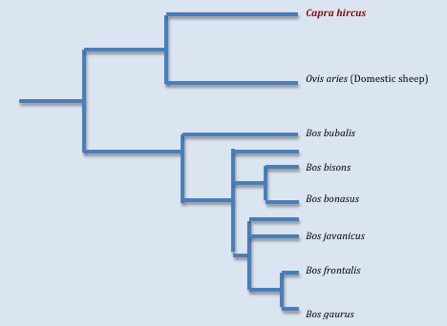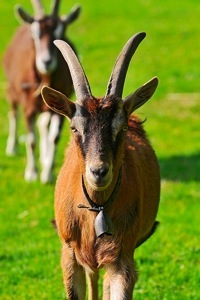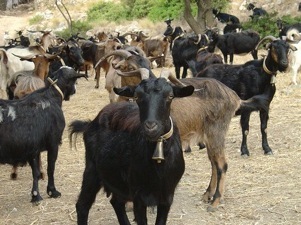Classification


“What Exactly is a Goat?”
Domain: Eukarya
The goat is classified as Eukarya because it has linear DNA
enclosed in membrane-bound nuclei within its cells.
Kingdom: Animalia
The goat is classified as Animalia because it is a multicellular
heterotroph with true tissues. In addition, its cells have no
cell wall.
Phylum: Chordata
The goat is classified as Chordata for many reasons. It is
triploblastic, meaning that it develops from three germ
layers, and has a coelom. In addition, it exhibits bilateral
body symmetry and has a segmented body, a complete
digestive system, and an endoskeleton. Lastly, during its development, the goat possesses a notochord, a dorsal nerve cord, pharyngeal gill slits, an endostyle, and a post-anal tail (which it keeps into its adult life).
Subphylum: Vertebrata
The goat is classified as Vertebrata because it has a vertebral column, or a backbone.
Class: Mammalia
The goat is classified as Mammalia because its body is covered in hair, it possesses glands, and it is homeothermic (self-regulates its body temperature).
Order: Artiodactylia
The goat is classified as Artiodactylia because it is paraxonic. In other words, it has an even number of toes and the plane of symmetry in its foot passes between its third and fourth digits.
Family: Bovidae
The goat is classified as Bovidae because it has horns on its frontals (the anterior portion of the skull) and is unguligrade, or has hoofs. In addition, the goat is an herbivore and has a four-chambered stomach.
Genus: Capra
The Latin name Capra means “she-goat”. All
members of this genus are different species of
goats and ibexes. Characteristics of this genus
include calloused knees, long, pointed ears,
and flat, upward-turning tails. Goats are
sexually dimorphic, so males also have chin
beards, a rank odor, and horns that increase in
length and weight with age, and lack a
preorbital gland.
Species: Capra hircus
The Latin name hircus means goat. Capra hircus therefore means “she-goat goat”. As this redundant name suggests, this is the member of the genus Capra that most people associate with the name goat. Capra hircus refers to what is commonly known as the domestic goat, or goat, and can also be used in reference to the feral or wild goat.
This phylogenetic tree shows the evolutionary relationship between some common members of the Bovidae family. The relationships are based on molecular differences found in the 5’ UTR segment of the SRY region on the Y chromosome through DNA sequencing. The length of the segments horizontally represents the amount of time since the evolutionary divergence of the organisms. As shown, the goat is more closely related to the domestic sheep than any of the other Bovidae.

This phylogenetic tree is not based upon evolutionary history, but rather shows the classification of organisms to families, subfamilies, genera and species. These classifications are made by comparing morphological traits. This tree does not include all groups, but shows how Capra hircus relates to other commonly known mammals.
Capra hircus.
Photo by Tambako the Jaguar
A herd of Capra hircus.
Photo by Malingering


